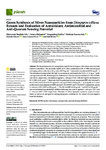Green Synthesis of Silver Nanoparticles from Diospyros villosa Extracts and Evaluation of Antioxidant, Antimicrobial and Anti-Quorum Sensing Potential
| dc.contributor.author | Adu, OT | |
| dc.contributor.author | Mohamed, F | |
| dc.contributor.author | Naidoo, Y | |
| dc.contributor.author | Adu, TS | |
| dc.contributor.author | Chenia, H | |
| dc.contributor.author | Dewir, YH | |
| dc.contributor.author | Rihan, Hail | |
| dc.date.accessioned | 2022-10-31T12:45:49Z | |
| dc.date.issued | 2022-09-26 | |
| dc.identifier.issn | 2223-7747 | |
| dc.identifier.issn | 2223-7747 | |
| dc.identifier.other | 2514 | |
| dc.identifier.uri | http://hdl.handle.net/10026.1/19792 | |
| dc.description.abstract |
<jats:p>The biosynthesis of silver nanoparticles (AgNPs) from Diospyros villosa leaves and stem bark extracts is described. The stem bark AgNPs of D. villosa synthesized at 80 °C (S80) showed good scavenging activity with a lower IC50 value of 8.75 µg·mL−1 compared to ascorbic acid (9.58 µg·mL−1). The total phenol content of the S80 AgNPs was measured and found to be 10.22 ± 0.14 mg.g−1 gallic acid equivalence (GAE). Bacterial growth inhibition (% GI) and violacein inhibition (% VI) of 10.08% and 58.83%, respectively, was observed against C.subtsugae CV017 with leaf AgNPs synthesized at 80 °C (L80) at 80 μg·mL−1. Stem bark AgNPs synthesized at room temperature (SRT) also indicated % GI of 13.83% and % VI of 65.97% against C. subtsugae CV017 at 160 μg·mL−1. Leaf AgNPs of D. villosa synthesized at room temperature (LRT), showed % GI of 29.07% and % VI of 56.53%, respectively, against C. violaceum ATCC 12472 at 320 μg·mL−1. The L80 and SRT at 160 μg·mL−1 and LRT at 320 μg·mL−1 may be considered as potential QS inhibitors following their activity against C. subtsugae CV017 and C. violaceum ATCC 12472, respectively. Therefore, D. villosa represents a potential source of antioxidants as well as an anti-quorum sensing therapeutic candidate for the control of Gram-negative bacterial infections.</jats:p> | |
| dc.format.extent | 2514-2514 | |
| dc.format.medium | Electronic | |
| dc.language | en | |
| dc.language.iso | eng | |
| dc.publisher | MDPI | |
| dc.subject | DPPH | |
| dc.subject | electron microscopy | |
| dc.subject | nanoparticles | |
| dc.subject | quorum sensing inhibition | |
| dc.title | Green Synthesis of Silver Nanoparticles from Diospyros villosa Extracts and Evaluation of Antioxidant, Antimicrobial and Anti-Quorum Sensing Potential | |
| dc.type | journal-article | |
| dc.type | Journal Article | |
| plymouth.author-url | https://www.webofscience.com/api/gateway?GWVersion=2&SrcApp=PARTNER_APP&SrcAuth=LinksAMR&KeyUT=WOS:000866914800001&DestLinkType=FullRecord&DestApp=ALL_WOS&UsrCustomerID=11bb513d99f797142bcfeffcc58ea008 | |
| plymouth.issue | 19 | |
| plymouth.volume | 11 | |
| plymouth.publication-status | Published online | |
| plymouth.journal | Plants | |
| dc.identifier.doi | 10.3390/plants11192514 | |
| plymouth.organisational-group | /Plymouth | |
| plymouth.organisational-group | /Plymouth/Faculty of Science and Engineering | |
| plymouth.organisational-group | /Plymouth/Faculty of Science and Engineering/School of Biological and Marine Sciences | |
| plymouth.organisational-group | /Plymouth/Users by role | |
| plymouth.organisational-group | /Plymouth/Users by role/Academics | |
| dc.publisher.place | Switzerland | |
| dcterms.dateAccepted | 2022-09-20 | |
| dc.rights.embargodate | 2022-11-1 | |
| dc.identifier.eissn | 2223-7747 | |
| dc.rights.embargoperiod | Not known | |
| rioxxterms.versionofrecord | 10.3390/plants11192514 | |
| rioxxterms.licenseref.uri | http://www.rioxx.net/licenses/all-rights-reserved | |
| rioxxterms.licenseref.startdate | 2022-09-26 | |
| rioxxterms.type | Journal Article/Review |


